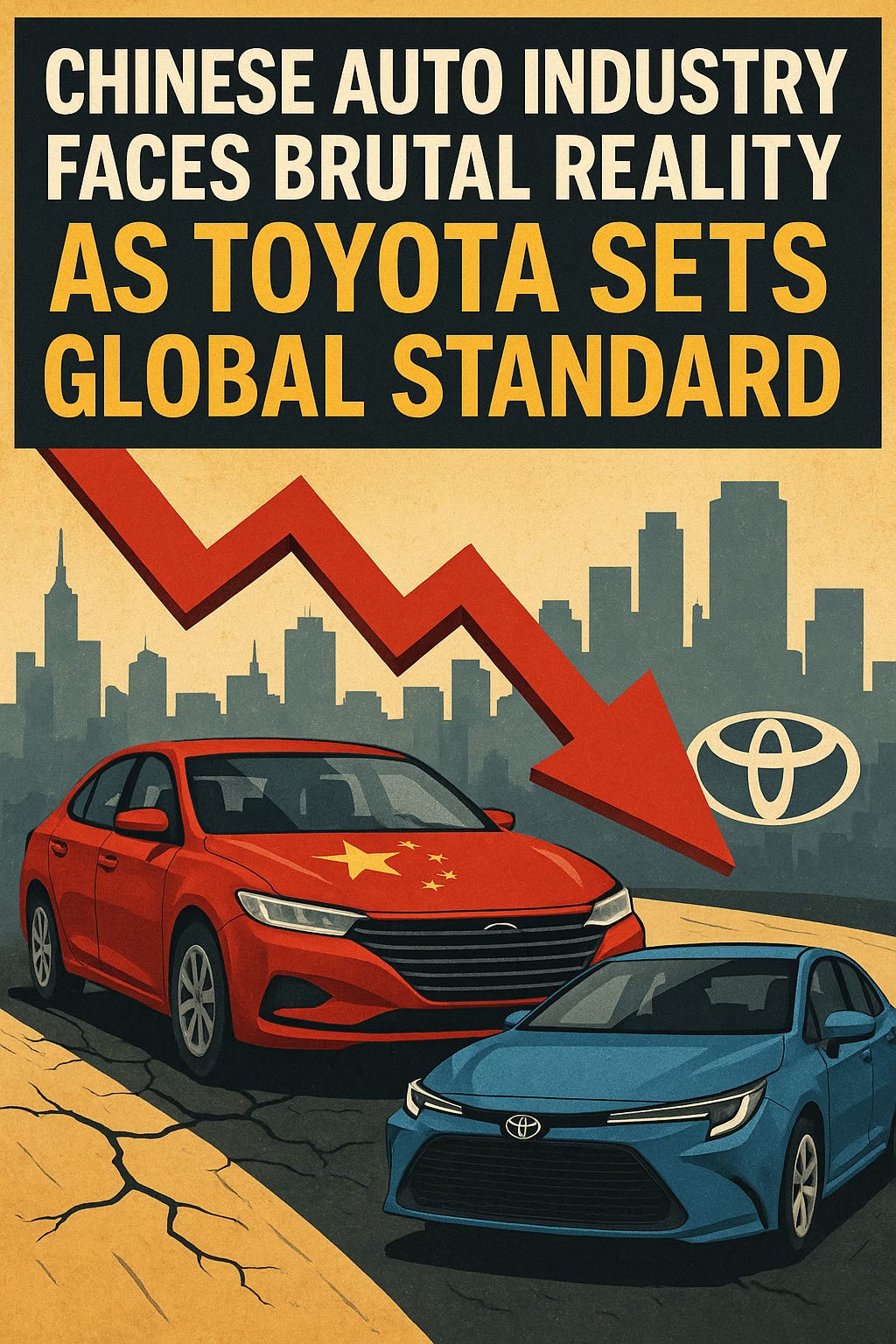🚗 Chinese Auto Industry Faces Brutal Reality as Toyota Sets Global Standard
🚗 Chinese Auto Industry Faces Brutal Reality as Toyota Sets Global Standard
In July 2025, former Chongqing Mayor Hongchi Fan ignited a firestorm in China’s auto sector with explosive remarks at the BEA Financial Annual Conference. His statements broke through the state’s usual propaganda and forced a reckoning: China’s entire automotive industry, despite selling 30 million vehicles annually, earns less profit than Toyota earns from selling just 9 million.
This startling disparity is more than just numbers—it reflects systemic issues in quality, innovation, and government interference.
📉 The Profit Gap: 30 Million Cars vs. 9 Million
Hongchi Fan laid it out plainly:
China: 30 million cars → ~$12.5B profit
Toyota: 9 million cars → ~$32B profit
Despite China’s massive EV boom, domestic manufacturers like BYD and NIO average only $182 per vehicle in profit. In contrast, Toyota earns over $3,190 per unit—nearly 17 times more.
🔧 Why the Gap Exists
Fan, who once worked at Volkswagen, explained what Chinese firms are missing:
Toyota’s Precision Culture
Every motion is measured; even walking steps on the assembly line are optimized.
Engineers favor simple clips over bolts to save material and weight.
Legendary attention to detail: “Purple screws” in Toyota’s cabins meet aviation standards.
Superficial Innovation in Chinese EVs
Giant touchscreens, dancing cars, and mini-fridges sound cool—until they break or distract drivers.
Critics call these “gimmicks,” not real engineering feats.
Manufacturing Standards Still Lagging
A Toyota screw is engineered for tool-less removal.
A Chinese car, in contrast, may show defects within 2–3 years, including rusting chassis and weak structural integrity.
🧨 The EV Price War: Race to the Bottom
Starting in 2023, BYD slashed prices dramatically—its Seagull EV dropped from $10,000 to $7,700.
Other companies followed, sparking a brutal price war that:
Wiped out $24.7B in market value
Left 3.5M unsold vehicles in inventory
Forced unsold cars to be sold as "0-km used cars"
Reduced industry profit margins to just 0.83%
The war backfired. Price cuts led to thinner margins, compromised build quality, and eroded consumer trust.
🛠️ Suppressing Criticism Instead of Solving Problems
The most damning section of the video is the government-industry response to critics:
Mechanics sued for pointing out design flaws
Social media influencers silenced or jailed for honest reviews
Troll armies and legal pressure used to erase negative content
A Beijing mechanic known as Brother Long was sued for $1M by multiple car companies. He wasn’t alone—two others were detained, and one BYD owner was jailed for 7 days after posting a breakdown video.
💸 Corruption & Government Pressure
The video exposed how systemic corruption in procurement leads to inferior parts.
With hundreds of suppliers competing for contracts, bribes are rampant. Poor quality materials find their way into production, raising safety concerns and undercutting durability.
Meanwhile, state subsidies have been misallocated to short-term gimmicks, not long-term engineering excellence.
📉 Financial Data Paints a Bleak Future
Chinese automakers now owe ¥959 billion ($132B)
Inventory levels have doubled in 6 years
Profit margins are shrinking
Payment terms to suppliers are worsening—up to 237 days in some cases
With over one-third of Chinese automakers expected to have negative equity by year-end 2024, a wave of bankruptcies is likely in 2026.
🧭 CCP’s Changing Tone?
Observers suggest Hongchi Fan’s speech was no accident. As a former high-ranking CCP official, his harsh honesty signals a possible policy pivot.
The government may be preparing to:
Cut subsidies to underperforming EV companies
Reduce intervention
Let market forces eliminate the weakest players—similar to what’s happening in real estate
⚙️ Final Thoughts
The Chinese auto industry is facing an identity crisis. Years of flashy design, cheap labor, and government backingcan’t compete with Toyota’s slow, disciplined excellence. Unless Chinese manufacturers pivot toward real quality, sustainable engineering, and open feedback—collapse is on the horizon.
As one critic in the video put it:
“Never solve the problem. Just eliminate the people who raise it.”
That may work in censorship—but not in global markets.

